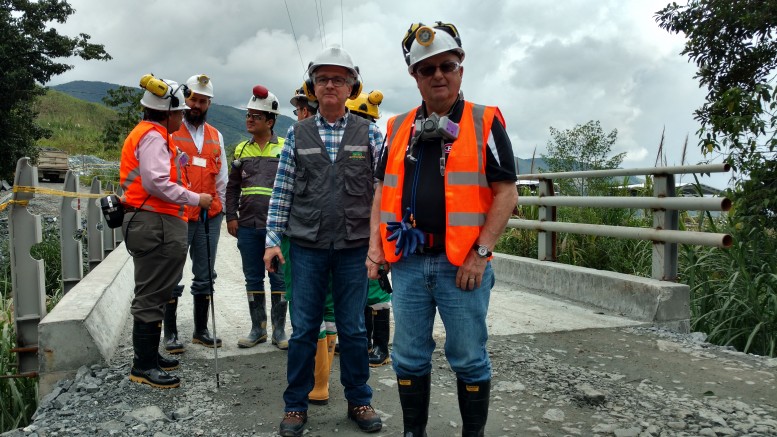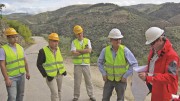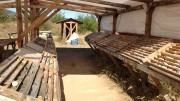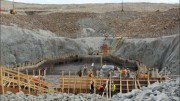MEDELLIN, COLOMBIA — It’s full steam ahead for Antioquia Gold (TSXV: AGD; US-OTC: AGDFX) at its Cisneros high-grade gold mine under construction 2 km east of the town of Cisneros in northwestern Colombia’s Antioquia department, with underground development well advanced and commercial production rates targeted to begin mid-2017.
Dozens of foreign gold-mining companies have descended on Colombia over the past decade, but Antioquia Gold stands with Red Eagle Mining (TSX: R) and Continental Gold (TSX: CNL) as one of only three that have achieved, or are soon to achieve, commercial gold production at newly built mines in the country — with all three mines located in the mining-friendly Antioquia department, where artisanal gold miners have been active for generations.
Red Eagle was first out of the gate with its San Ramon gold mine, where it poured first gold in November; Antioquia Gold will be second, targeting the third quarter of 2017 for start-up; and Continental Gold will likely be third at its larger Buritica project, where the firm recently obtained environmental permits that pave the way for mine construction to start in the second half of 2017, and gold production perhaps two years later.
The wholly owned, 58 sq. km Cisneros project is 55 km northeast of Medellin, or less than a two-hour drive from the big city, with most of the route being a newly extended four-lane highway. Infrastructure in the area is excellent.

Hauling out rock from the mine portal at the Guaico deposit at Antioquia Gold’s Cisneros gold project near Cisneros in Colombia’s Antioquia Department. Photo by John Cumming.
Antioquia Gold has already completed extensive underground development at the Cisneros property, which is divided between the Guaico deposit, which will be mined at a rate of up to 250 tonnes per day starting in July 2017, and the Guayabito deposit, 1.6 km northwest, which will be mined at a similar rate starting in March 2018 from a separate portal, though it will one day be connected via a tunnel to Guaico.
Gold mineralization at Cisneros is described as porphyry-related vein deposits, with gold hosted in structurally related shear zones up to 16 metres wide containing veins and veinlets of quartz and pyrite, with minor chalcopyrite and molybdenite.
Once all the latest drill results are in from Guaico and Guayabito, Antioquia plans to update its National Instrument 43-101 resource numbers by the end of March.
At last count in August 2013 — taking into account only the main Guaico zone (i.e., not including two new zones at Guaico named Manuela and Nus, or the significant Guayabito deposit) — the Cisneros property hosts 599,000 measured and indicated tonnes grading 5.05 grams gold per tonne for 97,100 contained oz. gold, plus 1.1 million inferred tonnes grading 4.90 grams for 173,000 contained oz. gold. These numbers are calculated based on 35,400 metres of drilling in 141 holes collared between 2008 and 2012. (By the end of 2012 there was another 10,000 metres of drilling in 59 holes not yet included in any resource estimate, and another 1,600 metres were drilled into the Guayabito South target in 2016.)
The mining method will be mechanized cut-and-fill complemented by cut-and-fill with special equipment, and some shrinking stoping. Backfill will be a combination of waste and hydraulic backfill.

In the distance to the left, as the valley deepens: where Antioquia Gold has acquired land to build a tailings facility with a capacity of 4.5 million tonnes for its Cisneros gold mine in Colombia’s Antioquia Department. Photo by John Cumming.
Antioquia’s processing plant, now under construction, will have an initial 250-tonne-per-day capacity by July, which will double next January, when mineralized material from Guayabito comes onstream.
Operating at a 500-tonne-per-day capacity under the original mine plan would translate to 30,000 oz. gold produced per year for a five- to seven-year mine life according to Antioquia Gold’s preliminary studies, but extending the known mineralized zones and adding the three gold-rich zones to the resource base will likely add mine life.
Gold will be recovered as free gold (55%) and in concentrate (45%), with gold shipped out as a concentrate to minimize any security problems related to pouring doré on-site.
Jim Decker, Antioquia Gold’s executive vice-president of investor relations, says there is “little difference” in the metallurgy of the property’s zones, which makes for relatively uncomplicated milling with 97% recovery. He adds that because the gold processing will not use politically sensitive cyanide, “that is the reason we got our permits so quickly.”

A development ramp into the Manuela gold zone at the Guaico deposit at Antioquia Gold’s Cisneros gold project in Colombia. Photo by John Cumming.
Antioquia also has a permit to store up to 4.5 million tonnes of tailings on land that it bought in an uninhabited portion of a valley west of the plant, but the company only intends to store 1.5 million tonnes of tailings in the first seven years of production. So there’s plenty of room to accommodate a longer mine life as the resource base grows.
As of November, Antioquia Gold had extended its main access ramp at Guaico to 922 metres long (advancing at a rate of 300 metres per month); spiralled the ramp down 110 metres from the mine portal’s elevation; raised a ventilation shaft; and carved out an underground explosives magazine to enhance mine security.
The host rock for all this activity is a sturdy diorite-intrusive named the Antioquia batholith, which Antioquia Gold says provides “excellent ground conditions” that need less money and effort spent on rock-bolting and similar stabilization work. The tunnels are also wide and high enough to allow using 40-tonne street dump trucks underground.
The idea is to go after the main Guaico vein first, but the two satellite high-grade vein structures accessible from the Guaico ramp — Manuela and Nus — are to be drilled off and incorporated into a future mine plan.
An underground drilling campaign further targeting the Guaico, Manuela and Nus zones is getting underway in January 2017.
“Rather than spend $3 million on exploration [on new gold zones at Guaico and Guayabito], we said: ‘We have enough already to get started,’” Decker says, noting the company has carried out internal studies, which it considers feasibility study level, but not to National Instrument 43-101 standards. “We had the critical mass to develop a mine here at 30,000 oz. a year for seven years. We said, OK, we have enough information for that, so let’s not drill from surface — we’ll drill underground with shorter holes, and it’ll be much cheaper. And we can use the cash flow from the mine operations to pay for it.”
Because of this approach, even as Antioquia spirals down to mine the main Guaico vein, it has also splayed off the main ramp towards the Manuela zone — reached by a development ramp in November — and is targeting the Nus zone on the other side of the Guaico vein zone.
“The Nus resources are lower grade, but they have tremendous, tremendous lateral potential, because the Nus veins go parallel to the fault, while the others are perpendicular to the fault,” Decker says.
“We’re seeing drill intersections of 5 to 6 grams gold at Nus, which is respectable for underground, but it’s nowhere near the 10s, 20s and 30s we’ve seen in the other zones. We have no mine plan for Nus yet, but now that we’re down there we can drill it and explore it.”
Meanwhile the 1,200-metre drilling program into the Guayabito South target has extended the high-grade gold deposit by at least 150 metres and upgraded resources into the indicated category.
“We got spectacular results. These are jewellery box numbers,” Decker says of the assays released in early October, with the best hole, No. 10-95, cutting 4.6 metres of 38.1 grams gold, 3.5 metres of 19.6 grams gold and 4.5 metres of 17.5 grams gold.

Section view of the main gold zones at Antioquia Gold’s Cisneros gold project in Colombia. Credit: Antioquia Gold.
A 450-metre drilling campaign is underway at Guyabito to upgrade the resource.
Antioquia Gold extended a road through the hills to the planned mine portal at Guayabito. And after receiving environmental approvals for Guayabito in November 2016, preliminary tunneling work got underway in December by the same contractors that are excavating the underground workings at Guaico.
After the Guayabito approval, Antioquia president, CEO and chairman Felipe Ferraro said that the firm “continues to be committed to the region and the country in the development of a model project of responsible mining that applies the highest environmental standards, and that is developed in harmony with its surrounding communities.”

At Antioquia Gold’s corporate offices in Medellin, Colombia (from left): Julián Villarruel, president of Antioquia Gold’s Colombian subsidiary; and Jim Decker, executive vice-president of investor relations. Photo by John Cumming.
The company cautions that it has not completed an official preliminary economic assessment, prefeasibility study or feasibility study at Guayabito, and that while it believes its “best use of resources is to go forward with mine development and construction” at Guayabito, it acknowledges there is “increased uncertainty and higher risk of economic and technical failure” associated with the decision.
Compared to other gold juniors, Antioquia Gold has been in a relatively strong financial situation through the downturn in the gold sector, thanks to the backing since 2010 of its key Lima-based shareholder: privately held mining company Infinita Prosperidad Minera S.A.C. (formerly Desafio Minero).
Infinita has proven an enthusiastic, technically proficient and deep-pocketed shareholder that has provided Antioquia Gold cash in stages to cover the Cisneros mine’s anticipated US$40-million total capital costs. Infinita’s extensive gold mining experience in Peru has also given it the confidence to sign off on Antioquia Gold’s higher-risk plan to build a mine without an official feasibility study in hand.
With Infinita converting another $4.5 million in loans into shares in October, the Peruvian miner now owns 70% of Antioquia Gold’s shares, or 214.6 million shares — up from a 62% interest previously.
At the end of September 2016, Antioquia Gold had $2 million in assets (including $1 million in cash) and $12.6 million in liabilities (not counting the $4.5-million loan subsequently converted into shares).
Antioquia Gold shares last traded at 12¢ in a 52-week range of 6¢ to 16¢. With 306.8 million shares outstanding, the market capitalization is $35 million.
RELATED STORIES:Antioquia to proceed with underground mine at Cisneros
Site visit: Antioquia Gold has high hopes for Cisneros and Colombia






Be the first to comment on "Site visit: Antioquia Gold pushes Cisneros to production"